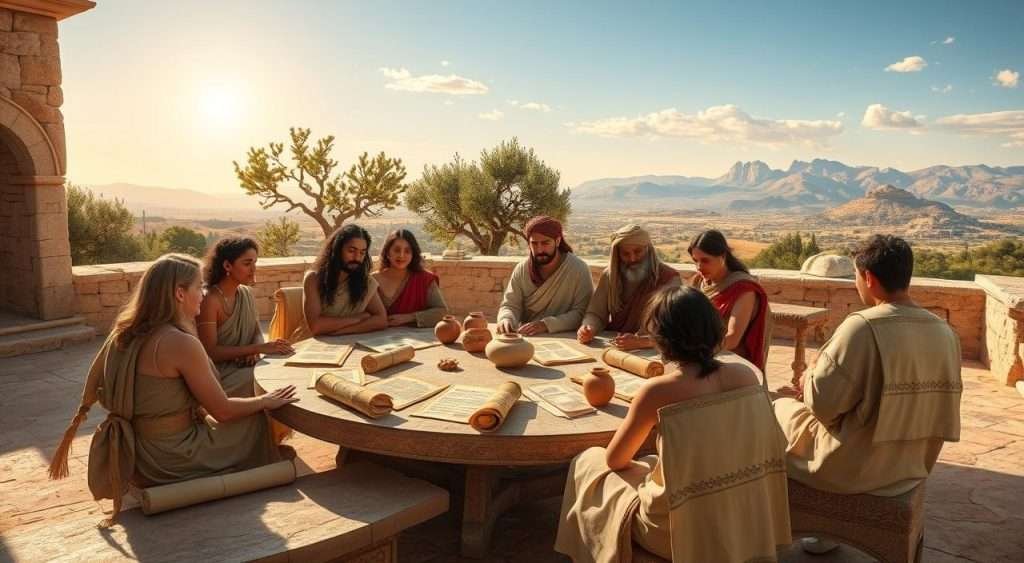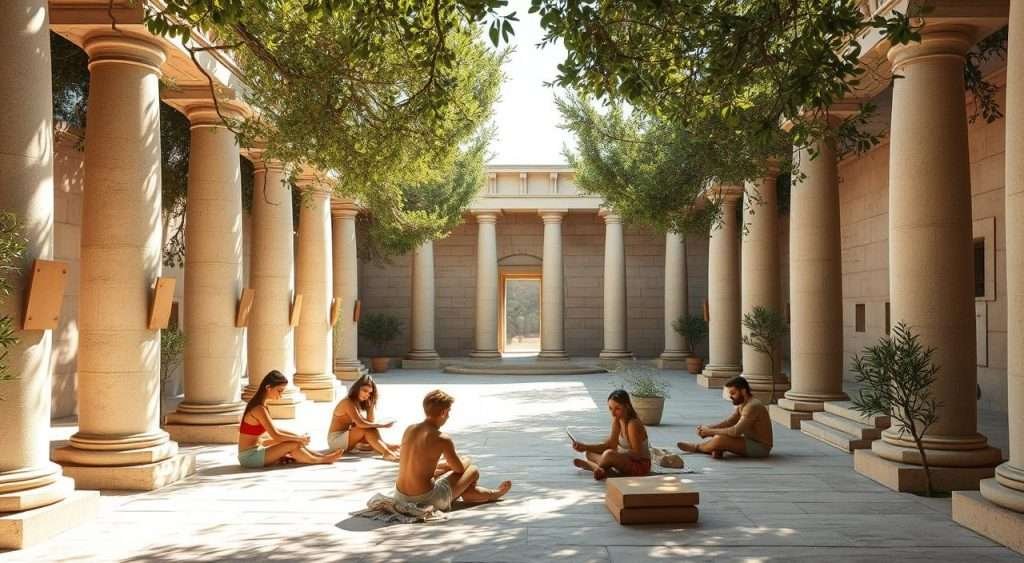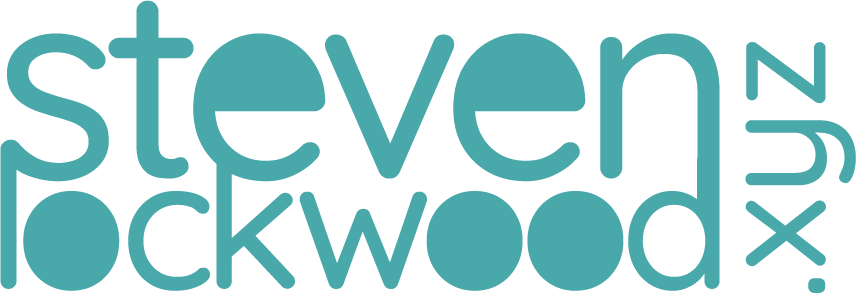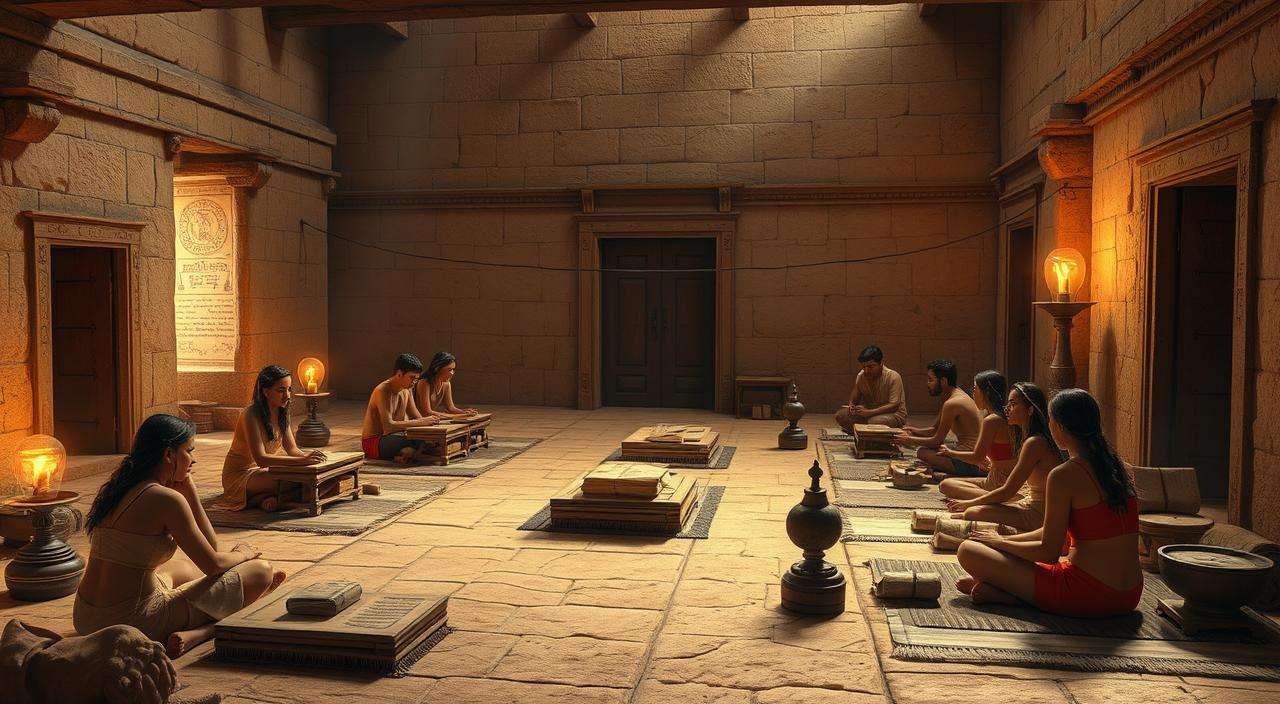The history of education is a captivating journey that spans centuries and transcends cultures. As we embark on this exploration, a tantalizing question arises: who truly invented the concept of school as we know it today? To uncover the answer, we’ll delve into the origins of education. We’ll trace its evolution from ancient civilizations to the innovative thinkers of the Renaissance and beyond.
From the earliest forms of learning to the development of formal schooling, we’ll uncover the pivotal moments and influential figures that have shaped our modern educational systems. Along the way, we’ll challenge common beliefs and unlock the fascinating story behind the foundations of education.
Join me on this captivating journey as we explore the history of education and discover the untold stories behind the “invention” of school. Prepare to be enlightened, inspired, and perhaps even surprised by the remarkable evolution of learning throughout the ages.
The Ancient Roots of Education
The history of formal education starts with ancient Mesopotamia and Egypt. These places had the first known education systems. They set the stage for education today.
Exploring the First Schools in Mesopotamia
In Mesopotamia, the first schools were in temples. These places were where students learned about math, astronomy, and literature. Scribes and priests taught here, passing on knowledge that shaped history.
The Evolution of Learning in Ancient Egypt
In ancient Egypt, learning was also valued. Scribes and priests kept knowledge alive. They recorded Egypt’s achievements, from records to art and architecture.
The education systems in Mesopotamia and Egypt showed the values of their cultures. These early educators helped start formal schooling. Their work has influenced learning for centuries.

| Mesopotamia | Ancient Egypt |
|---|---|
|
|
The education systems of Mesopotamia and Egypt were key. They set the stage for formal schooling and the pursuit of knowledge for ages to come.
The Legacy of Ancient Greek Education
The ancient Greeks made big steps in education. Pioneers like Plato and Aristotle started schools and new teaching ways. They focused on thinking deeply and learning more. Their ideas changed education for the better.
At the core of Greek education was a love for wisdom and growing the mind. Students in these schools had tough debates. They learned about math, philosophy, and science, and were encouraged to question everything.
- The pioneers of education in ancient Greece, such as Plato and Aristotle, believed that education should focus on developing the whole person, not just imparting knowledge.
- The Greek educational system placed a strong emphasis on the development of critical thinking and problem-solving skills, which would become hallmarks of Western education.
- The curriculum in ancient Greek schools typically included subjects like grammar, rhetoric, music, and physical education, reflecting the Greeks’ holistic approach to learning.
The legacy of ancient Greek education is still felt today. It’s seen in the value of the liberal arts, growing the mind, and critical thinking. These ideas shape education worldwide, showing how the ancient Greeks influenced our views on learning.
“The direction in which education starts a man will determine his future in life.” – Plato
| Key Contributions of Ancient Greek Education | Impact on Modern Education |
|---|---|
| Establishment of influential academies, such as Plato’s Academy and Aristotle’s Lyceum | Inspired the creation of universities and other higher education institutions |
| Focus on the development of the whole person, including physical, intellectual, and moral education | Influenced the holistic approach to learning in modern educational systems |
| Emphasis on critical thinking, problem-solving, and the pursuit of knowledge | Shaped the core values and pedagogical approaches of Western education |
| Curriculum centered on the liberal arts, including subjects like grammar, rhetoric, music, and philosophy | Inspired the continued importance of the liberal arts in contemporary education |

The Rise of Formal Schooling in Rome
As the Roman Empire grew, so did its education system. The Romans created a more organized way of learning. They focused on important subjects like rhetoric, law, and public administration. This change helped shape the education we know today.
The Influence of Roman Educational Practices
The Romans were true innovators in education. They started using textbooks and set up schools at different levels. This method of learning became the base for schools worldwide.
The Roman education model also emphasized learning for public service and law. Students were prepared for careers that helped the empire grow and stay stable. This focus on practical skills was key.
| Key Roman Educational Practices | Impact on Modern Education |
|---|---|
| Use of Textbooks | Established the foundation for standardized curriculum and learning materials |
| Structured School Levels | Paved the way for the development of primary, secondary, and tertiary education |
| Emphasis on Public Administration and Law | Highlighted the importance of practical, career-oriented education |
The Roman education system’s impact is still seen today. Their innovative teaching methods and school structures are still used in schools around the world.
“The Roman educational system laid the foundation for many of the teaching methods and organizational structures that are still used in schools today.”
Medieval Monasteries and the Preservation of Knowledge
In the Middle Ages, monasteries were key places of learning. They played a big role in keeping and sharing knowledge. These places offered education to both church leaders and regular people, guiding education through that time.
The Role of Monastic Schools in Medieval Europe
Monastic schools, like those started by Charlemagne, were centers of learning. They taught a wide range of subjects, like theology and the arts. These schools were dedicated to learning, helping keep the origin of schools alive and supporting the development of schools in medieval Europe.
“Monastic schools were the beacons of intellectual life, preserving the flame of knowledge amidst the darkness of the Middle Ages.”
The impact of monastic schools was huge. They educated not just future priests but also laypeople. This openness helped education spread beyond the church, preparing the way for universities and more schools later on.
The legacy of medieval monastic schools shows human spirit’s strength. Despite turmoil, these places kept the origin of schools alive. They set the stage for the education milestones that would shape learning’s future.
The Renaissance and the Revival of Classical Learning
The Renaissance was a key time in education’s history. Scholars brought back the learning of ancient Greece and Rome. This led to a focus on the humanities, arts, and knowledge.
Figures like Erasmus, Petrarch, and Michelangelo led this movement. They made learning about ancient texts and ideas popular again. This sparked a love for learning that changed education.
Classical learning’s return changed education a lot. Universities started to focus on the liberal arts, philosophy, and sciences. Places like the University of Bologna, the University of Cambridge, and the University of Oxford became important.
“The revival of classical learning during the Renaissance transformed the way we think about education, inspiring a renewed focus on the humanities and the pursuit of knowledge.”
Also, the Renaissance brought new ideas in education. People like Vittorino da Feltre and Erasmus pushed for a more rounded education. They believed in learning that covers physical, intellectual, and moral growth.
The Renaissance’s impact on education is still felt today. It led to changes and new schools that formed the modern university system. This era was a turning point in education’s history, setting the stage for future developments.
who invented school: Tracing the Origins of Modern Schooling
The birth of modern schooling is tied to the printing press, invented in the 15th century. This innovation was key in spreading education worldwide. It made books and knowledge available to many, starting the modern school system.
The Renaissance added to this growth by focusing on learning. This mix of new tech and a love for knowledge made schools more open to everyone. No longer just for the rich, schools became places for all to learn.
The Impact of Printing on Education
Before the printing press, books were rare and only for the wealthy. The press changed this by making books common. This sparked a desire for learning and led to more schools.
The printing press made education available to more people. It made society more literate and informed. This led to set curricula, textbooks, and more schools beyond old circles.
The printing press and the Renaissance changed education forever. They made learning universal and accessible. This revolution helped schools evolve, making knowledge for all.
“The printing press is the greatest weapon in the armory of the modern educator.”
– George Bernard Shaw
Pioneers of Educational Reform
Throughout history, visionary thinkers have changed education. They challenged old ways, created new teaching methods, and focused on students. These innovators have made a lasting impact on how we teach and learn.
Influential Thinkers Who Shaped Modern Education
John Comenius, a 17th-century Czech scholar, is known as the “father of modern education.” He believed in universal education for all children, no matter their background. His work, “The Great Didactic,” showed the value of visual aids, practical learning, and child curiosity.
Jean-Jacques Rousseau, an 18th-century Swiss philosopher, also changed education. His ideas in “Émile, or On Education” supported learning at one’s own pace. He believed in hands-on exploration and nurturing children’s talents.
The Montessori Method by Maria Montessori has greatly influenced education. It focuses on a prepared environment for self-directed learning. Children learn through hands-on activities, developing their skills.
These pioneers have shaped today’s education. Their work continues to influence learning in the 21st century.
| Educational Innovator | Key Contributions | Impact on Modern Education |
|---|---|---|
| John Comenius |
|
Laid the groundwork for modern teaching methods and the concept of student-centered learning |
| Jean-Jacques Rousseau |
|
Influenced the progressive education movement and the focus on child-centered learning |
| Maria Montessori |
|
Transformed the way we think about early childhood education and the role of the teacher as a facilitator of learning |
“The great purpose of school can be no other than to awaken the natural desire of learning.” – Jean-Jacques Rousseau
The Birth of Public Education Systems
The 19th century was a key time for schools and modern schooling. It was when public education started. Thinkers like Horace Mann in the U.S. and William Forster in the U.K. led this change.
Public education became universal, compulsory, and free. This was a big step towards making learning available to everyone. It made sure education wasn’t just for the rich anymore.
This change was a big step forward. It made sure everyone had a chance to learn. This helped create a more informed and powerful society.
| Country | Year of Compulsory Public Education |
|---|---|
| United States | 1852 |
| United Kingdom | 1880 |
| Germany | 1819 |
| France | 1882 |
“Education is the most powerful weapon which you can use to change the world.” – Nelson Mandela
The Evolution of Teaching Methods and Curricula
The history of education has seen big changes in teaching and what’s taught. Educational innovators have pushed for better ways to learn. This has changed schooling a lot.
Innovations in Pedagogy and Learning Approaches
The Montessori method, by Maria Montessori, is a big change. It focuses on the child, letting them learn by doing. It creates a space that helps kids explore and grow.
Project-based learning is another big change. It lets students solve real problems in groups. This helps them think critically and be creative.
| Teaching Methodology | Key Characteristics | Impact on Learning |
|---|---|---|
| Montessori Method |
|
|
| Project-Based Learning |
|
|
New teaching methods and tech in the classroom have changed teaching and learning. The evolution of schooling keeps going. Teachers and researchers keep looking for new ways to improve education.
The Spread of Education Around the World
Education’s story isn’t just about the West. Cultures worldwide have shaped education’s history. From ancient China and India to modern Africa and Latin America, education has evolved globally.
The spread of education is complex. It’s influenced by colonialism, cultural exchange, and technology. When societies meet, they share and adapt educational ideas, creating new models.
China’s ancient education system is a great example. It influenced Japan, Korea, and Vietnam. India’s focus on Sanskrit and oral knowledge also shaped education in Southeast Asia.
In Africa, education has been shaped by many influences. Missionary and colonial schools have left marks. Yet, African educators have made education reflect local cultures and needs.
Latin America’s education history is also rich. It spans from pre-Columbian times to modern movements. This shows education’s ability to adapt to change.
The spread of education is a global story. It shows how diverse cultures have influenced each other. Understanding this history helps us see how education has evolved worldwide.
The Role of Technology in Transforming Education
In today’s digital world, schooling has changed a lot because of new technology. From the start of modern schools to the work of educational leaders, tech has been key. It has changed how we learn.
Digital tools have changed how students get and use information. E-learning sites, AI apps, and online groups have made learning more personal and fun.
Exploring the Impact of Digital Tools on Learning
Technology has a big effect on education. It lets teachers make lessons more exciting and gives students lots of resources. Online platforms, interactive boards, and virtual labs have made classrooms more interactive and fun.
- More access to learning materials
- More chances for learning that fits each student
- More options for learning from home or in a mix of settings
- More use of data to help learning adapt
As tech keeps getting better, schooling will keep evolving. Using digital tools in class can change how we teach and learn. This could shape the future of education.
“Technology has the power to transform education, empowering both students and teachers to reach new heights in the pursuit of knowledge.”
Addressing the Challenges of Modern Education
The history of education has been long and changing. Modern schooling has grown a lot. Today, the education system faces many challenges. We need to focus on ensuring everyone gets a fair chance to learn and using new technologies.
One big issue is making sure everyone has access to good education. Some groups don’t get the same chances. We need to change policies, fund schools better, and teach in new ways to help all students.
Using new technology in schools is also a big challenge. Digital tools can change learning, but using them well is hard. Teachers must find a balance between old and new teaching methods to keep students interested and learning well.
Also, how we teach needs to keep up with the world. The job market and what students need to learn are always changing. We must create education that is flexible and ready for the future.
Finally, students’ mental health is a big worry. School can be very stressful. We need to support students better and focus on their overall well-being.
To improve education, we must find new ways to solve these problems. We need to work together, use technology wisely, and care for our students. This way, we can make sure education meets the needs of today’s world.
| Challenge | Potential Solutions |
|---|---|
| Educational Equity | Policy reforms, targeted funding, innovative teaching methods |
| Technology Integration | Balanced approach, effective implementation, teacher training |
| Curriculum Relevance | Flexible, future-oriented programs, alignment with job market demands |
| Student Well-being | Comprehensive support systems, holistic approach to student development |
“The function of education is to teach one to think intensively and to think critically. Intelligence plus character – that is the goal of true education.” – Martin Luther King Jr.
The Future of Learning: Trends and Innovations
The evolution of schooling is set to change even more. Trends like personalized learning and virtual reality are coming. These changes will make learning more fun and fit each student’s needs.
These educational innovators will shape our future learning. From the birth of modern schooling to today’s tech, learning will keep getting better.
Exploring Emerging Educational Philosophies and Practices
Personalized learning is a big deal now. It uses data and tech to tailor lessons for each student. This makes learning more engaging and prepares students for today’s world.
- Virtual and augmented reality are coming to classrooms. They make learning interactive and fun. Students can explore digital worlds and learn in new ways.
- Learning is also becoming more hands-on. By mixing subjects and projects, students learn to think and work together. These skills are key for today’s world.
The evolution of schooling will keep evolving. New practices aim to make students lifelong learners and community leaders.
“The future of education is not about teaching students what to think, but how to think.”
Conclusion
The history of education is a story of human creativity, strength, and the endless quest for knowledge. It spans from ancient times to the modern era, showing how learning places have grown to be key in our lives. This journey through educational history highlights the vision of pioneers and key moments that shaped today’s schools.
Exploring the roots of education, we see the human spirit’s ability to adapt and grow. It shows how people have always sought to learn more and improve themselves and society. The story of who started schools and the evolution of modern education is a tribute to those who believed in education’s power.
Knowing this rich history helps us face today’s challenges and opportunities. It ensures education keeps driving positive change and improving our world. Looking ahead, we must use past lessons to create schools that empower, inspire, and build a fairer world.

